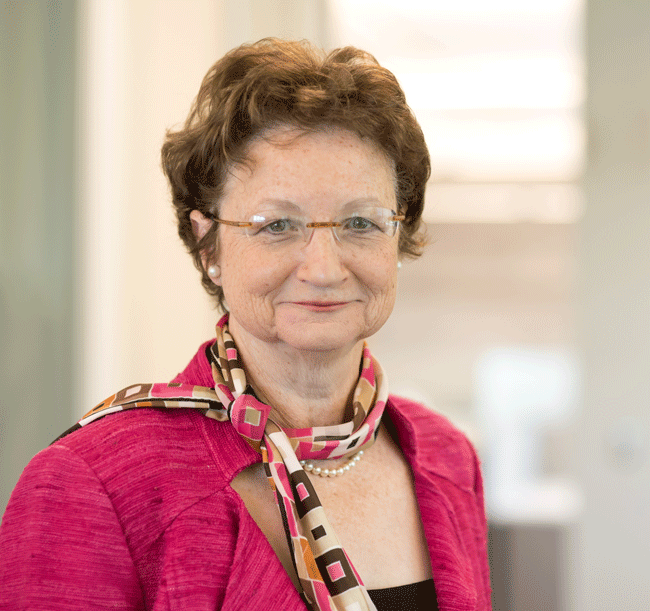From hospital funding to FDA approval
Spark Therapeutics develops gene therapy for inherited retinal blindness
 After over two decades of research and development in gene therapy, Katherine A. High, MD, co-founder, president and chief scientific officer of Spark Therapeutics, is breathing a big sigh of relief this fall. On Oct. 12, the Food and Drug Administration unanimously voted to approve voretigene neparvovec, Spark Therapeutics' gene therapy treatment for inherited blindness stemming from a mutation in RPE65. Reflecting on the long road to commercialization, High shared some of the challenges her team faced along the way.
After over two decades of research and development in gene therapy, Katherine A. High, MD, co-founder, president and chief scientific officer of Spark Therapeutics, is breathing a big sigh of relief this fall. On Oct. 12, the Food and Drug Administration unanimously voted to approve voretigene neparvovec, Spark Therapeutics' gene therapy treatment for inherited blindness stemming from a mutation in RPE65. Reflecting on the long road to commercialization, High shared some of the challenges her team faced along the way.
ARVONews: Spark Therapeutics has come a long way from its roots at the Children's Hospital of Philadelphia (CHOP). Can you provide a quick overview of Spark's development?
High: The decisions that eventually enabled the creation of Spark occurred in 2004 at CHOP, when the hospital decided to commit resources for the required regulatory and clinical-grade manufacturing resources that would allow us to move forward our gene therapy research programs using adeno-associated viral (AAV) vectors. Because of high-profile adverse events in the gene therapy field a few years earlier, resources for production of clinical grade AAV had become scarce. Being able to produce our own material allowed us to continue research into treatments for hemophilia, which is my original field, and expand into inherited retinal blindness by collaborating with Jean Bennett, MD, PhD, scientific co-founder and advisor at Spark Therapeutics. I worked with her on her work with RPE65, which had already been shown to be effective in dogs.
After several years of optimizing our lead candidate and overcoming the regulatory hurdles necessary to allow clinical trials with children from the beginning, we were ready to pursue a Phase I/II clinical trial. This showed safety and also indications of efficacy. Due to the massive resources necessary to pursue a Phase III trial, it became best for CHOP to spin us out as Spark Therapeutics in 2013. In fact, the hospital was the first investor in Spark Therapeutics.
We announced the positive results from the Phase III trial in September 2015. The Biologics Licensing Application was filed in May 2017 — the first application for an AAV product in the U.S. — and the Phase 3 clinical trial results were published in the Lancet in July. This investigational product was the subject of the FDA Advisory Committee meeting in October, with a decision expected by FDA in January 2018.
ARVONews: The road from a small team in CHOP to a publicly traded company with a budget in the tens of millions of dollars seems long and intimidating. Could you highlight some key decisions that helped Spark grow?
High: Our ability to attract some really terrific people as we've grown from our original small unit at CHOP to the about 300 employees now at Spark has been one reason why we've been so successful. Another reason is the series of scientific decisions we made around our clinical candidate — design of the vector, design of the clinical program, surgical innovation, etc. We were very careful about every single element and it has paid off. Finally, I would say my decision to end my association with the Howard Hughes Medical Institute (HHMI) was important as well. They are one of the best funders a researcher could have, but my association with them would have limited my ability to pursue my work with Spark.
ARVONews: How have the scientific challenges you've faced changed from your early days to today? How has your ability and resources to respond to those challenges changed as well?
High: I think a good example is our production of vector. When we produce a batch of vector, we have 30 different assays we use to characterize it. When we shifted to Spark, we had to put a great deal of resources into validating each of those assays. A lot of people and expertise were required to develop the quality assurance and quality controls necessary for commercialization.
ARVONews: Do you have any advice you'd like to share to other ARVO members pursuing their own research?
High: My approach to dealing with research problems is to acknowledge the problem and then bring everything you have to bear on it. I would say stick it out, don't turn away from a problem but push through it.
A thought that has always heartened me is that this research has really helped patients. That makes me feel the work, the long nights and the missed dinners with my kids was worth it. I've also really enjoyed working with super talented people. That's its own kind of reward. MW
